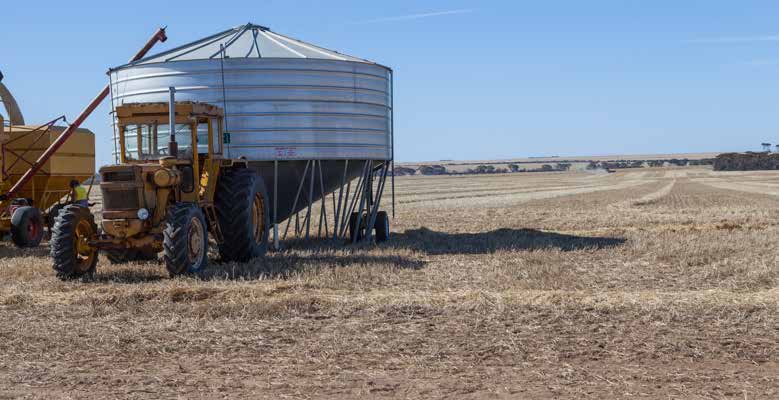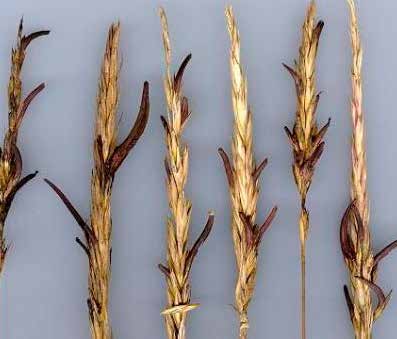Giving a rats summer 2015


"GRDC Project UA00124 – Understanding and management of
resistance to Group M, Group L and Group I herbicides"
The Australian Glyphosate presents a summary of the research on Sustainability working Group had
how to keep those fence lines free of
INDEX FOR THIS ISSUE
its annual face-to-face meeting in
resistant weeds.
Adelaide last August and discussed a range of topics critical to keeping
There is a lot of pressure on farmers to
glyphosate effective across a range
optimise their time when spraying so
of areas, not just broadacre cropping.
multiple mixes in the spray tank are one approach. This can become a nightmare
The Group heard how the managers
if there is any incompatibility leading
of South Australian roads are dealing
to poor weed control and blockages in
with widespread glyphosate resistant weeds, which pose a safety hazard to
the sprayer. Dow formulation chemist
drivers and threaten adjacent farmland.
Rob Buttimor gives us some practical advice to avoid any stuff-ups.
It looks like they are getting the upper
hand which is great news. Also a senior
In many parts of this great nation
viticulturalists with the Australian Wine
of ours the weeds are growing and
Research Institute brought the group
robbing us of valuable soil moisture
up to date with how the grape wine
which can greatly affect sowing times
industry are managing glyphosate
and final winter crop yield. The GRDC
resistance across the highly variable
has release a new publication which
wine regions of Australia. What was
gives you all the information needed
clear was that there is no one approach
to get the best control of summer
and each area uses different strategies
fallow weeds.
to manage their weeds. While these presentations talk about diversity
While on this topic it is useful to note
of management the Group also had
that one company has put in the work
discussions with companies about to
and updated their fallow herbicide
introduce crop cultivars with "stacked"
labels to include application using the
resistance traits. These are closely
Weedseeker™ and WeedIt™.
controlled and monitored in Australia and the aim of the discussions was to look at a standard approach to minimising resistance risk in weeds when using these technologies.
In this edition of Giving a RATS we discuss how ryegrass ergot has given southern Western Australian farmers an opportunity to figure out which of
There is no such uncertainty as
their herbicides is still effective before the plant the 2015 crop. With the
a sure thing.
widespread adoption of dry seeding this is an opportunity that should not
Robert Burns 1759 - 1796
After three years of research and plenty of media, Sally Peltzer from the Department of Agriculture & Food WA



OF ST ANTHONY'S FIRE AND KNOWING IF YOUR HERBICIDES STILL WORK
While rainfall totalling over 200 mm across parts of southern
If your post emergent herbicides don't work, you had better
Western Australia in late spring created widespread ryegrass
make sure you are seeding into weed-free paddocks.
ergot problems at harvest it could provide a real boon for farmers. Strict grain receival standards limiting the amount
ver the past two years have
of ergot forced many farmers to grade grain before delivery
shown over 40 per cent of paddocks tested have some level
resulting in remnant heaps of weed seeds. The reason for
of glyphosate resistance.
strict standards is that ergot contamination of flour causes
This indicates we are close to a tipping point when
a horrible disease known in the Middle Ages as St Anthony's
glyphosate resistance is likely to start becoming obvious in
cropping paddocks.
Figure 1. Seed grading to reduce ryegrass ergot in the grain sample, southern WA. Source: AGRONOMO
Ergot contamination of grain however presents growers with a valuable opportunity as many large heaps of ergot and weed seeds such as ryegrass, brome grass and wild radish sit in the corners of paddocks around their farms. These heaps give farmers a chance to test for herbicide susceptibility before the coming season.
Currently only a small percentage of growers test weeds for herbicide susceptibility and the gradings from ryegrass ergot presents them with a ready source of seed to see which of their herbicides still works. Surveys of agronomists and farmers have found that one of the reasons for low levels of testing is that growers are too busy to collect samples before or at harvest so this is a chance not to be missed.
Growers need to know which herbicides are still effective on their major weeds so testing your most commonly used herbicides is a good start. Further advice on which herbicides to get tested should be done with your adviser and the testing service that you plan to use.
If you are a fan of ‘dry seeding', and many WA growers are,
Figure 2. Ergot in cereal rye. Source: www.plantsincivilization.wordpress.com
knowing if your herbicides still work is particularly important.
Page 2 Edition 11 Summer 2015


OF ST ANTHONY'S FIRE AND KNOWING IF YOUR HERBICIDES STILL WORK
A History of Saint Anthony's Fire
On 15 August 1951 one in twenty of the
4000 inhabitants of another village in France
called Pont Saint Esprit (Bridge of the Holy
Spirit) went mad. They had hallucinations,
writhed in agony in their beds, vomited, ran
through the streets and suffered terrible
burning sensations in their limbs. They were suffering from St Anthony's Fire,
a dreaded illness that was common in the
Middle Ages. The cause was poisoning from
rye ergot, a fungus that contaminated the
rye flour used in making bread. In the Middle Ages, the gangrenous
poisoning was known as "holy fire" or "Saint
Anthony's fire", named after monks of the
Order of St. Anthony who used to treat this
ailment along with ‘the plague'.
Ergot contains a chemical that gives
the sufferers hallucinations and causes
gangrene of the hands and feet due
to constriction of blood supply to the
extremities. If it is not treated victims had
the sensation of being burned at the stake,
before their fingers, toes, hands and feet
Figure 3. Part of the Isenheim Alter painted by Matthias Grunenwald circa 1512 showing a victim of St Anthony's fire – ergotism. Source Wikipedia
Knowledge is power, so now is the time to find out what you
Ergot contains ergotamine. In moderate
are dealing with.
doses, ergotamine causes the contraction
The two weed seed testing services available in Australia
of smooth muscle fibres, such as those in
are provided by Peter Boutsalis' Plant Science Consulting
small arteries. Ergotamine has been used
(PSC), in South Australia, and John Broster at Charles Sturt
to control haemorrhage (bleeding) and to
University (CSU), in NSW.
promote contraction of the uterus during
They take mature weed seeds collected during or after
childbirth. It is also used to treat migraine
harvest, grow these out in controlled environments from
headaches (its major use today).
December to February, treat the weed plants with the herbicide/s requested by the grower and then assess survival.
In large doses, ergotamine paralyses the
motor nerve endings of the sympathetic
More information about these services is available at:
nervous system. The disease ergotism
(St. Anthony's fire) is caused by excessive
intake of ergot, usually by eating baked
It is recommended samples are sent before the end of
goods made with contaminated flour,
January (in paper bags/envelopes - not plastic) so results are
as happened in the Middle Ages. Acute
available before the beginning of the cropping season.
and chronic ergotism are characterized
DAFWA ergot information
by mental disorientation, convulsions,
muscle cramps, and dry gangrene of the
University of Nebraska ergot fact sheet
Page 3 Edition 11 Summer 2015

DON'T FENCE ME IN - THREE YEARS OF FENCE LINE TRIALS IN WESTERN AUSTRALIA
For the past three years, the Northern and Esperance Advisor Groups (set up as part of the GRDC-funded herbicide resistance project UA00124) have looked at annual ryegrass and other weed control in fence lines for resistance management.
In 2012, the two groups compared 13 herbicide treatments (applied as either single herbicides (glyphosate, paraquat, amitrole, glufosinate or amitrole + paraquat) or as a mixture of a residual herbicide with paraquat) with glyphosate at two trial sites (Esperance and Dalwallinu).
Î Tank mixes of residual herbicides
plus either paraquat or amitrole + paraquat gave the best control of annual ryegrass, wild radish and other grasses and broadleaf weeds.
Î Applications of bromacil offered
the best control at both locations.
Î The herbicide treatments were
applied in August which tends to be a common time for many growers. In August however the weeds are often large and harder to control.
In 2013, two earlier (but single) application times (May and early July) of a further range of herbicides were explored in four locations, Miling,
Figure 4. Remnant wild radsish and summer weeds taking over fence line near Lake Grace. Source: AGRONOMO
Dandaragan, Geraldton and South Stirlings.
Î Similarly, tank mixes of residual
KEY MESSAGES
herbicides plus a knockdown
Î A two spray or ‘double knock' strategy (including cultivation or another non-
gave the best control.
herbicide treatment) is often required for complete weed control along fences
Î No treatment gave complete
with the first treatment early in the season followed by another one later in
the season (after the seeding and post-harvest operations are over).
In 2014, the groups decided that
Î Tank mixes of a residual herbicide plus a knockdown give the best control for
two control timings were needed,
the first application.
once early in the year with a good
Î A single application of a mixture of bromacil (Uragan®) plus paraquat early in
residual and a knockdown, followed
the season gives excellent weed control along fences.
by another one later in the season (after the seeding and post-harvest
Î The addition of amitrole + paraquat (Alliance®) as the knockdown gives good
operations are over). That way you set
broadleaf weed control.
up the fencelines early in the season
Î Glyphosate can still be used BUT intensive monitoring and complete seed set
then kill them off later rather than
is required to prevent resistance from developing.
having to spray big fat weeds in in one pass. As bromacil was now registered
Fences can be a ‘breeding' ground for glyphosate resistance due to the lack of crop
for fence lines (Uragan® is the only
competition, its repeated usage and the often late applications when weeds are
product registered for fences), it was
large and harder to control. Controlling weeds that grow along fences is important
included as a single application mixed
to prevent their move into cropping fields taking their resistance status with them.
with paraquat at the early timing.
Page 4 Edition 11 Summer 2015
DON'T FENCE ME IN - THREE YEARS OF FENCE LINE TRIALS IN WESTERN AUS
Cultivation and slashing were also included in some of the treatments.
Î A single application of bromacil plus paraquat in May (or June in Esperance) gave complete
control of all weeds (annual ryegrass, wild radish, mallow, capeweed, turnip, clover, volunteer cereals) at all sites with both rates (3.5 and 5 kg/ha).
Î Bromacil seems expensive but only one application is needed to control all weeds (including
summer weeds) for at least one year. As bromacil is highly residual, there is a risk of soil erosion where there is no vegetation to hold onto it and a risk to the crop if soil is blown onto it. It is toxic to trees so can only be used where there is no remnant vegetation.
Î At most locations an application of either simazine
plus amitrole + paraquat or simazine, 2,4-D and paraquat in May followed by a second application of atrazine plus paraquat in August gave over 95 per cent control. The addition of amitrole + paraquat gave slightly better control where there were broadleaf weeds (three years results).
Î Delaying the application of the first spray reduced
the control by 10 to 30 per cent across all sites.
Î Slashing later in the season then spraying with
atrazine and paraquat showed promise in the southern areas (80-98 per cent control) where the season was later and there had been more rain. There was poor control (56-59 per cent) in the
Figure 5. Sally Peltzer discussing the benefits of bromacil as a fence treatment at Stirlings2Coast Field Day,
northern trial sites.
2014. Source: AGRONOMO
Î The use of cultivation as a control option did not
work well in this series of trials due to the wet spring.
Sally PeltzerDAFWA Albany
Figure 6. Sally Peltzer with East Wagin group in October 2014 discussing why a single winter application of paraquat + simazine was ineffective. Source: AGRONOMO
Page 5 Edition 11 Summer 2015
GET THE MIX RIGHT OR REGRET IT AT YOUR LEISURE
With growers trying to reduce the number of spray passes
role in tank mix success. A recent round of "Better Spray
on a paddock there is a great temptation to start mixing
Application" workshops highlighted the fact that many
multiple products in the one tank, often with five or six
growers do not have a good understanding of their water
products, which can include two or three herbicides, an
insecticide and some form of adjuvant.
Add to this the fact that there are over 300 branded
To add further complexity to the scenario, the wide variation
adjuvant products on the Australian market with 30
in the quality of water being used also plays a significant
different active ingredients, it is no wonder agronomists and farmers can get into trouble.
Reading the herbicide label usually gives a good indication of what the company considers as compatible with their product although this information might sometimes not be as detailed as the user would desire.
An excellent resource is Table 33 in NSW Department of Primary Industries'which looks at a wide range of pesticide compatibilities.
The pesticide user needs to remember a pesticide active ingredient has to be formulated to be:
Î As biologically effective as possible in controlling
the pest/weed/disease
Î Physically and chemically stable in storage
(minimum of 2 years)
Î Easy to mixÎ Compatible with other pesticidesÎ Stable as a spray solution
To achieve these qualities a range of other chemicals are mixed with the active ingredient and these are known as ‘inerts'. These ‘inerts' include:
Î BuffersÎ DispersantsÎ De-foamersÎ SolventsÎ Emulsifiers Î Dyes
Another complication is that formulations for the same active ingredient usually vary from manufacturer to manufacturer. The ‘inert' ingredients will also vary in quantity and quality.
As this can be complicated we asked Rob Buttimor, a Formulation Chemist with Dow Agrosciences for a few tips about chemical compatibility and how we can assess what mixes work.
It might sound trite, but read the label: there is a lot of good information on spray volumes and compatibility to be found.
Figure 7. Rob Buttimor, Dow Agrosciences, checking the pH and hardness of the Tasman Sea. Source: R Buttimor
Page 6 Edition 11 Summer 2015
GET THE RIGHT MIX OR REGRET IT AT YOUR LEISURE CONT.
The major factors that cause spray tank incompatibility include:
Figure 8. Ooooops! A combination of hard water, acidification and low spray volumes! Source: R. Buttimor
Î Spray volumes - higher spray volumes tend to have
fewer problems as there is ‘more room' in the solution for the various components. i.e. the more concentrated the solution/brew is the higher propensity for chemical reactions to occur
Î The greater the variety of formulations (formulation
type and active type) added to the spray tank, the greater the chance of problems, such as the active coming out of solution and becoming ineffectual.
Î pH – This is only a problem in extreme cases (i.e. when
the pH is above 8). In most typical scenarios glyphosate adjusts the pH to the correct level due to its chemical nature, so it is encouraged that you test your spray mix pH after the glyphosate is added, not your "water" pH. Acidifiers (such as LI-700®) are only required in extreme cases, unless they are being used for another purpose, in which case the pH effect on the brew needs to be considered
Î Hardness – Metal ions such as calcium and magnesium
can be problematic, chemically binding/reacting with the active in the spay mix. This can result in physical incompatibilities such as gelling. High levels of bicarbonate can also affect Group A herbicides and 2,4-D amine. Avoid brackish water and ensure you test bore water for hardness before using. Rain water is always the best bet to avoid any hardness issues.
With soluble liquids (SL) the amine salt used in the formulation (such as dimethylamine, isopropylamine, etc.) will dictate the compatibility of the formulation with other products and water quality. Some companies will add conditioners to their formulations to improve the compatibility. Suspension
Figure 9. Who would want a truck load of this? Source: R. Buttimor
concentrates (SC) generally mix well with all water and other formulations.
In general, follow the correct mixing order, give lots of spray
or EDTA (edatic acid). This covers up hard water ions
volume and try a jar test.
that may cause incompatibility issues.
How to conduct a jar test:
Î Add granules / flowables / powders and mix well.
These take time to mix in so don't rush it.
Î In a 500 mL jar mix the same ratio of chemicals with
the same water at the same temperature and let it sit
Î Add emulsifiable concentrates and crop oils before
for 5 hours.
soluble liquids, this allows the emulsion to set up first. Add soluble liquids, such as glyphosate - the ions
Î Look carefully for crystals that would cause spray filter
added at this stage are less likely to interfere with the
Î Look for oil or general glug - a slight cream is not a
Î Add wetters (e.g. BS-1000). These are surfactants and
have to be added after emulsifiable concentrates
Î Remember, a small amount of problem in the jar can
have formed an emulsion. Adding these at the end
mean big problems in the tank!
also results in less foaming.
Follow the proper mixing order (general guidelines below,
Î Top up with water to final spray volume.
but read the label to verify):
For more information:
Î Fill tank two thirds with clean water, turn on agitation.
Make sure there is lots of room for the formulations to
GRDC Mixing Requirements for spray operations Fact Sheet -
Î Add water conditioners such as ammonium sulphate
Page 7 Edition 11 Summer 2015
STUBBLES FULL OF WEEDS AFTER SPRING AND SUMMER RAINS
Heavy spring rains in some parts of the cropping belt and now rains during January in other areas have created a significant summer weed problem for many growers including fleabane (Conyza spp.), sowthistle (Sonchus spp.), melons (Cucumis spp. & Citrullus spp.), common heliotrope (Heliotropium
europaeum), caltrop (Tribulus terrestris) and various annual grass species.
Reports have also been received of annual ryegrass germinating in western Victoria over the past few weeks although much of this is likely to die with the return of hot weather.
A great deal of research across Australia has shown significant benefits to keeping weeds controlled over the summer fallow, including the GRDC Southern and Western regions. Benefits include higher yields in below average rainfall winters as well as the ability to establish crops earlier with less autumn rain. This is becoming more important as winter rains become less reliable.
A new reference manual Summer Fallow Weed Management, published by the Grains Research and Development Corporation (GRDC), demonstrates how growers can reap a high return on investment from managing summer weeds. The publication was co-authored by Andrew Storrie, of AGRONOMO, and John Cameron, of ICAN Pty Ltd.
.
Figure 11. Click to see entire booklet.
Figure 10. Fleabane and sowthistle just after harvest and ready for spraying. Source: AGRONOMO
Page 8 Edition 11 Summer 2015
OPTICAL SPOT SPRAY TECHNOLOGY ADDED TO LABELS
With the adoption of optical spot spray technology (OSST), using either WeedIT® and WeedSeeker®, on many farms across Australia, Nufarm has added OSST as a new registration to many of its fallow products including paraquat, 2,4-D, 2,4-D + picloram, amitrole and fluroxypyr.
Researching the use of fallow herbicide products with OSST's by Nufarm began in 2008 after Andrew Storrie, then Technical Specialist Weeds with NSW Department of Primary Industries, began discussions in 2007 with Crop Optics and the various chemical companies to develop a permit to cover the use of this application technology .
Like the permit, the Nufarm registrations are designed to control weed cover up to 30 per cent of the field. If the percentage of weed cover exceeds 30 per cent, growers should use approved broadacre boom spray rates.
OSST allows growers to apply higher rates to achieve good control of larger difficult to control weeds such as fleabane, sowthistle, melons, windmill grass, feathertop Rhodes grass and barnyard grass, as well as glyphosate resistant escapes.
Because up to 30 per cent of the paddock is being sprayed, it makes the higher rates being applied cost effective.
While OSST is great for these hard to control weeds, only young, actively growing weeds should be sprayed.
Figure 12. Weedseeker™ in action. Source: Crop Optics
Page 9 Edition 11 Summer 2015
Andrew StorrieTelephone: +61 89842 3598
Page 10 Edition 11 Summer 2015
Source: http://www.agronomo.com.au/storage/newsletters/11-Summer-2015.pdf
CONVOCATORIA PARA LA INVITACIÓN A CUANDO MENOS TRES PERSONAS DE CARÁCTER NACIONAL NUM. INP-007-13 INSTITUTO NACIONAL DE PSIQUIATRÍA "RAMÓN DE LA FUENTE MUÑÍZ" SUBDIRECCIÓN DE RECURSOS MATERIALES De conformidad con la Ley de Adquisiciones, Arrendamientos y Servicios del Sector Público, se convoca a los interesados a participar en la Invitación a cuando menos tres personas número INP-007-13, cuya convocatoria que contiene las bases de participación disponibles para consulta en Calzada México-Xochimilco No. 101, Colonia san Lorenzo Huipulco, C.P. 14370, Tlalpan, distrito Federal, Teléfono 4160-5012, 4160-5014 y fax 4160-5292 los días lunes a viernes del año en curso de las 09:30 a 14.00 horas.
IN THE NAME OF THE QUEEN DISTRICT COURT THE HAGUE Civil law section Judgment of July 2, 2008 in the case having case number / cause-list number 293668/ HA ZA 07-2628 of NOVARTIS AG, a legal entity under foreign law, having its registered seat and principal place of business at Basel, Switzerland, plaintiff in the main action, defendant in (partly conditional) counterclaim proceedings, procurator litis: previously mr W. Heemskerk, presently mr P.J.M. von Schmidt








